
94% of researchers rate our articles as excellent or good
Learn more about the work of our research integrity team to safeguard the quality of each article we publish.
Find out more
ORIGINAL RESEARCH article
Front. Neurosci., 06 February 2023
Sec. Visual Neuroscience
Volume 17 - 2023 | https://doi.org/10.3389/fnins.2023.1105158
This article is part of the Research TopicOcular Neurodegenerative Diseases: Novel Mechanisms, Diagnosis, and Therapeutic StrategiesView all 18 articles
Background: Glaucoma is the first irreversible and second blindness disease, which is characterized by the death of retinal ganglion cells (RGCs) and degeneration of the optic nerve. Previous works have indicated that apoptosis is the main reason for RGC death in glaucoma. Although many studies have investigated the mechanism of apoptosis and different strategies targeting apoptosis to protect the RGCs and finally recover the impaired vision in the glaucoma. However, the global trend and hotspots of apoptosis in glaucoma have not been well illustrated and discussed.
Methods: Documents were extracted from the Web of Science Core Collection on November 2, 2022. We selected articles and reviews published in English from January 1, 1999 to November 1, 2022 to perform visual analysis and statistical analysis of countries, institutions, authors, references and keywords by VOSviewer 1.6.18 and CiteSpace 5.8.
Results: The publications about apoptosis in glaucoma show an increasing trend over time. Besides, the authors, institutions in the US and China published the most numbers of articles with the highest citation, which may be leading the research in the field of apoptosis in glaucoma. Last, series of advanced research results, technology and treatment for glaucoma, such as the discovery of key regulatory mechanisms on RGC apoptosis are emerging and will provide precise strategies for the treatment of glaucoma.
Conclusion: This research will broaden our comprehension about the role of apoptosis in the process of glaucoma, and provide guidelines for us in basic research and disease treatment in the further.
Glaucoma affects 80 million people worldwide (Ju et al., 2022; Liu et al., 2022). It is characterized by the death of retinal ganglion cells (RGCs) and the degeneration of the optic nerve, ultimately leading to progressively impaired vision (Wang et al., 2017a; Chen et al., 2022b). High intraocular pressure (IOP) is thought to be the primary risk factor for RGC death (Hu et al., 2020; Ju et al., 2022). Previous studies have indicated that apoptosis is the main reason for RGC loss in glaucoma (Hu et al., 2021; Cordeiro et al., 2022). Apoptosis is a type of programmed cell death that usually occurs in developing tissues and during homeostasis in organisms (Wang et al., 2019; Yan et al., 2022, 2023). Apoptosis is characterized by chromatin condensation, nuclear fragmentation, and the formation of apoptotic bodies (Zhang et al., 2021; Wang et al., 2023). In recent decades, many studies have indicated that RGC apoptosis occurs in glaucoma, and the mechanisms of RGC apoptosis have been widely investigated (Hu et al., 2021; Cordeiro et al., 2022). In addition, different strategies targeting apoptosis to protect RGCs and recover impaired vision in glaucoma are emerging (Chitranshi et al., 2018; Cordeiro et al., 2022). However, the global trends and research hotspots of apoptosis in glaucoma have not been well illustrated and discussed.
Compared to a review in general, bibliometric analysis is a mathematically and statistically feasible discipline to summarize and predict current and future research hotspots and trends by evaluating specific research areas based on main authors, research institutes, journals, citation frequency, keywords, etc (Hu et al., 2022; Zhang et al., 2022). CiteSpace and VOSviewer are two common and important bibliometric analysis software (Chen et al., 2022a; Zhang et al., 2022; Zhao et al., 2022). By using them alone or in combination, we obtain a better analysis of research trends and hotspots according to different specifications (Romero and Portillo-Salido, 2019; Zhao et al., 2022).
Our group focused on the research of apoptosis and necroptosis in the nervous system, which is involved in glaucoma and trauma. A bibliometric analysis broadens our understanding of existing research hotspots, future trends, and implications of apoptosis in glaucoma and other diseases, which can help to clarify the research status and identify the latest and most influential progress. In addition, a bibliometric analysis may provide us with useful tools to make clinical decisions and propose guidelines by analyzing keywords about drugs, examination, and treatment (Dai et al., 2022).
In this current study, we aimed to summarize and analyze the current research hotspots and future research trends of apoptosis in glaucoma using bibliometric analysis. This study deepens our understanding of the role of apoptosis in glaucoma and provides guidelines for basic research and disease treatment in the future.
The data retrieval strategy and collection process for this study are shown in Figure 1. We collected the bibliographic data in the Web of Science Core Collection (WoSCC) and download the “Full record and cited references” of the literature in “plain text” format. We screened target literature based on: (1) search formula: ALL = (glaucoma and apoptosis); (2) Document type: “Article” and “Review”; (3) Publication date: 1 January 1999 to 1 November 2022; (4) Literature Language: English. The search was completed on 2 November 2022. Our initial search for research papers on glaucoma and apoptosis was first published in 1999, so we set our search to start in 1999. We ended up with 1,674 documents that met the criteria.
Bibliometrics is an efficient tool that helps researchers visualize the evolution of published literature. The analytical dimensions of bibliometrics include the year of publication, country and region, institution, journal, author, keywords, and co-citations. We imported the data from WoSCC into VOSviewer (version 1.6.18; https://www.vosviewer.com/downloavosviewer) and CiteSpace (version 5.8.R3; https://sourceforge.net/project/citespace/files/latest/do). CiteSpace and VOSviewer can be used to analyze the potential information contained in complex data, and present the structure, law, and distribution of information through visual means. Co-occurrence analysis refers to counting the frequency of occurrence of multiple phrases in the same article to determine their proximity, so as to obtain hot spots and future trends in the discipline. Co-citation analysis is used to discover the basic literature and knowledge in this research field (Romero and Portillo-Salido, 2019). The result provides information on the past, present, and future dimensions of the research field. In addition, we used Microsoft Office Excel 2021 to analyze trends in published articles over time.
In the visualization map below, each circle represents a node, and the diameter size of the circle represents how often the label appears in the co-occurrence analysis. The color of a circle is determined by the cluster of categories to which it belongs. The connection between nodes represents the association of the corresponding node, and the strength of the association between nodes is expressed in line width.
The annual publication trend of apoptosis in glaucoma is shown in Figure 2. From 1999 to 2022, the amount of literature in this field increased from 1999 (n = 23, 1.37%) to 2021 (n = 132, 7.89%), and peaked in 2021. As of November 2022, we believe that the number of publications in 2022 will increase, following previous years' trends.
VOSviewer was used to analyze the authors' countries, regions, and partnerships, and the results are shown in Figure 3. Table 1 lists 10 countries with the highest number of publications. China published the most literature (482 documents and 7,217 citations), but the United States was the most influential country in this field (468 documents and 24,687 citations) in terms of overall citations. A network of coauthors from 40 countries or regions with more than three studies was divided into eight cluster groups with different color representations. The largest cluster (red) consisted of nine countries centered in the United States, the United Kingdom, and Canada.
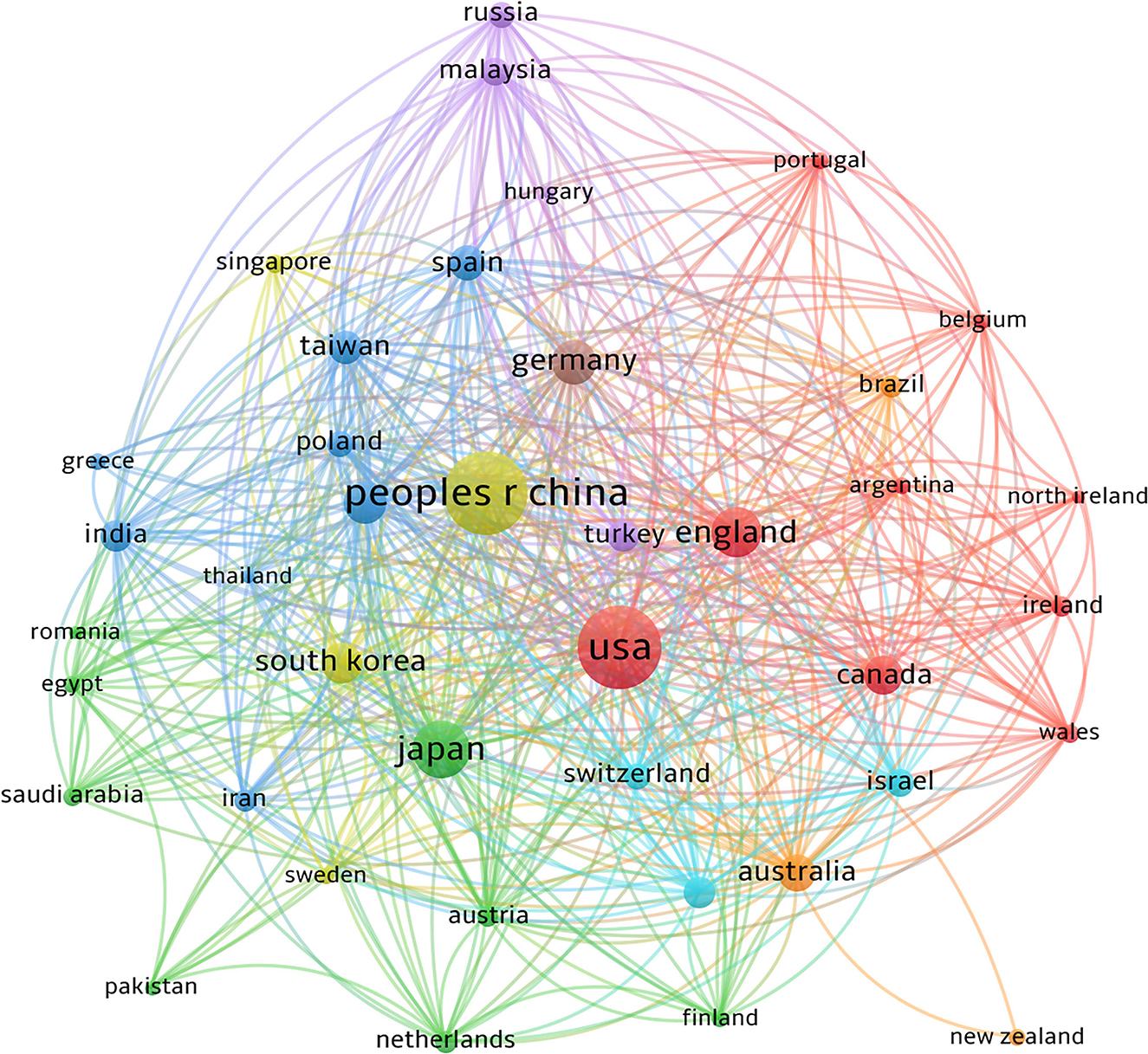
Figure 3. A total of 56 countries or regions have participated in the study of apoptosis in glaucoma. China and the United States are at the center of the study. The red cluster is centered in the United States. China's cooperation between countries and regions is relatively weak.
Articles on glaucoma and apoptosis were published in 435 journals. Table 2 lists the top 10 journals with the most publications, accounting for 31.7% (531 documents and 1,674 citations) of all publications, and the distribution has a strong head effect. Investigative Ophthalmology & Visual Science was the most prolific journal (154 documents) and the most cited (9,011 citations), followed by Experimental Eye Research (80 documents). Although Progress in Retinal and Eye Research published only four studies, it was cited 4,183 times, indicating that the journal has a high impact factor.
A total of 114 articles were cited more than 100 times. Table 3 lists the top 10 cited literature. Among them, “Muller Cells in The Healthy and Diseased Retina” (Bringmann et al., 2006), published in Progress in Retinal and Eye Research in 2006, was the most cited literature (1,178 citations). The lowest number of citations overall was 327.
The top 10 institutions with the highest number of publications are listed in Table 4. University of Wisconsin (48 documents and 2,754 citations) appears to be the most influential institution in the field, with the second-highest number of publications and the highest number of citations. Fudan University and Shanghai Jiao Tong University, two Chinese universities, have published more literature but have lower citations (526 citations and 522 citations, respectively).
The network of coauthors from the research institutions is shown in Figure 4. Regardless of the green or red cluster, the vast majority of cooperation is limited to the country.
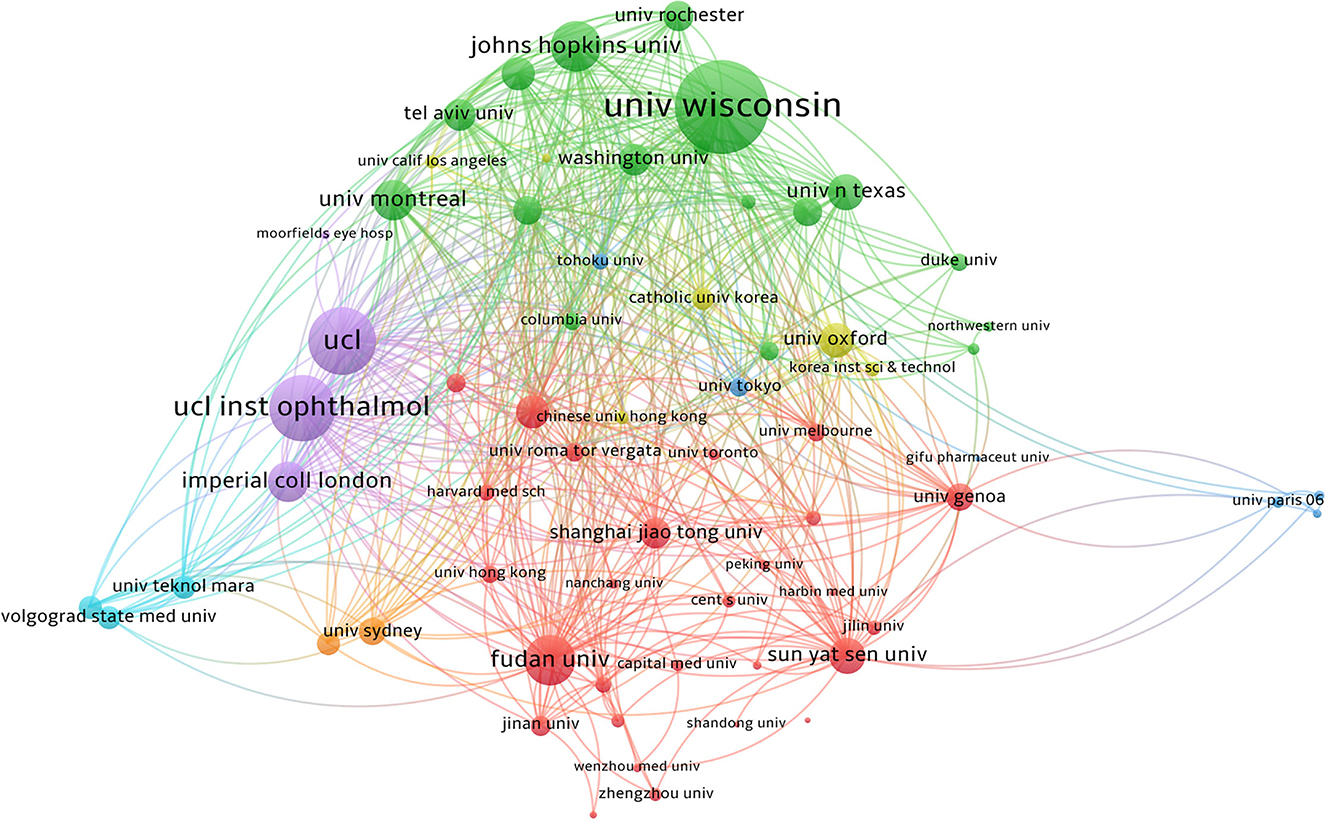
Figure 4. A total of 1,538 institutions participated in the study of apoptosis in glaucoma. The network of co-authors was divided into seven clusters of different colors. The green cluster is dominated by American institutions, and the University of Wisconsin had the greatest impact. The red cluster is dominated by Chinese institutions.
The top five authors who published the most articles were all from England, the USA, and China. Dr. Cordeiro from Imperial College London has published 22 articles over the past 31 years, ranking as the top author in the field of apoptosis in glaucoma. Table 5 lists the top 10 authors with the highest number of published articles. Cordeiro, M. Francesca (22 documents and 1,254 citations) was the most prolific, followed by Nickells, Robert W. (20 documents and 996 citations). We set the threshold to five documents and screened a total of 182 authors who met the criteria; the results are shown in Figure 5. There are nine color classifications, of which the largest is the red cluster, composed of 38 authors centered around Osborne, Neville N, Zhuo, and Yehong.
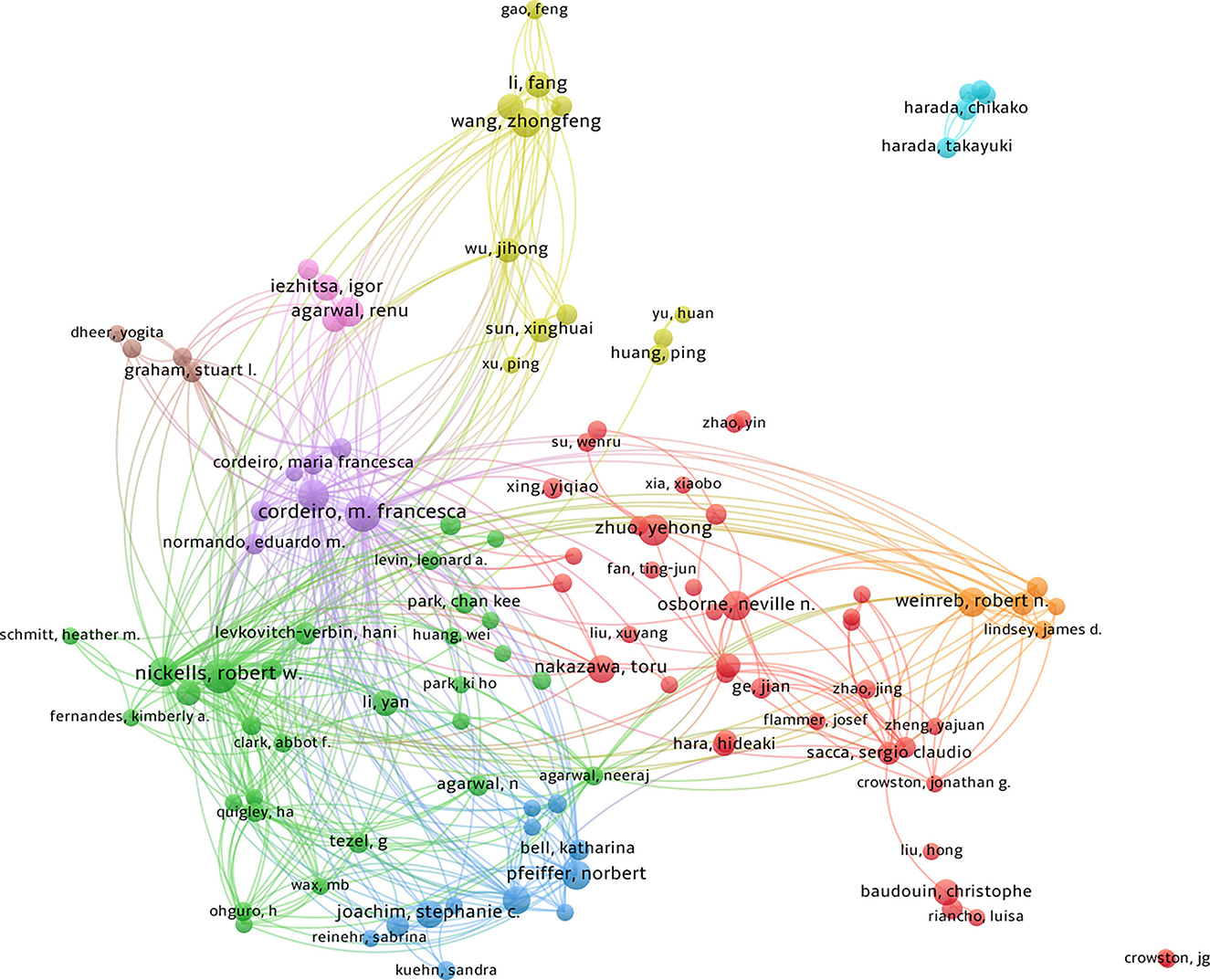
Figure 5. A total of 6,888 authors participated in the writing process. The Linlog/modular model was used for analysis. The weight is Total Link Strength. The size of the circle represents the amount of influence of the author. Inter-node connections represent author collaboration and the lines of connection between nodes represent the collaboration between authors.
We listed the top 10 citations in Table 6, with citations ranging from 96 to 231. As shown in Figure 6, the paper titled “Retinal ganglion cell death in experimental glaucoma and after axotomy occurs by apoptosis” (Quigley et al., 1995), published in Ophthalmology & Visual Science in 1995, has the most citations (231 citations).
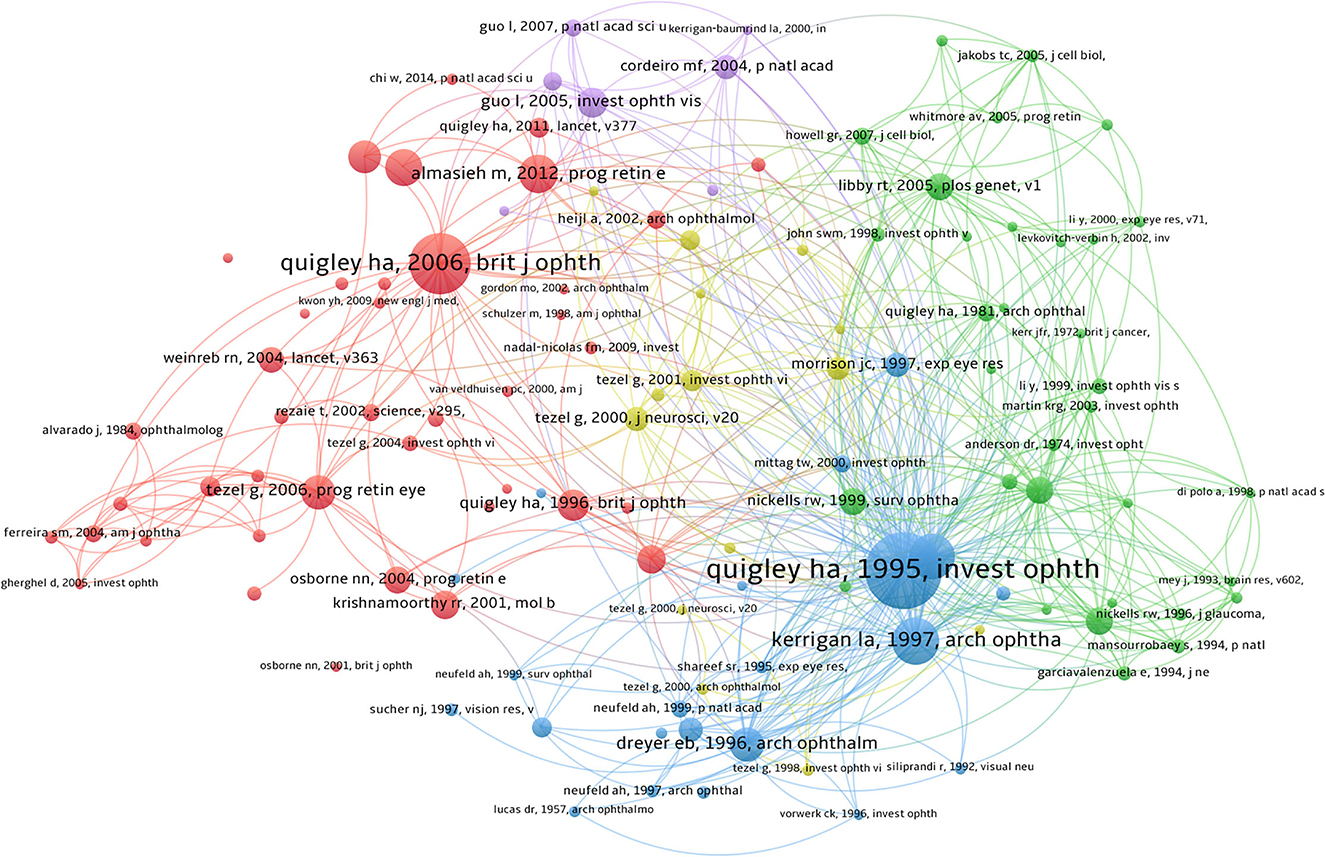
Figure 6. A total of 58,156 literature was cited from 1,674 retrieved literature. The two most cited articles in co-citation analysis were written by Quigley HA. The same color clusters indicate the documents are related or have some commonalities.
Figure 7 shows the top 20 documents with the strongest citation outbreaks. “TUNEL-positive ganglion cells in human primary open-angle glaucoma” (Kerrigan et al., 1997), published in Arch Ophthalmol in 1997, had the highest impact at 19.29. The study proposes that apoptosis plays an important role in nerve cell death in primary open-angle glaucoma. “Global prevalence of glaucoma and projections of glaucoma burden through 2040: A systematic review and meta-analysis” (Tham et al., 2014), published in Ophthalmology in 2014, has the most citation outbreaks in recent years, with researchers predicting that the number of glaucoma cases will increase to more than 100 million by 2040. This poses a significant threat to human eye health.
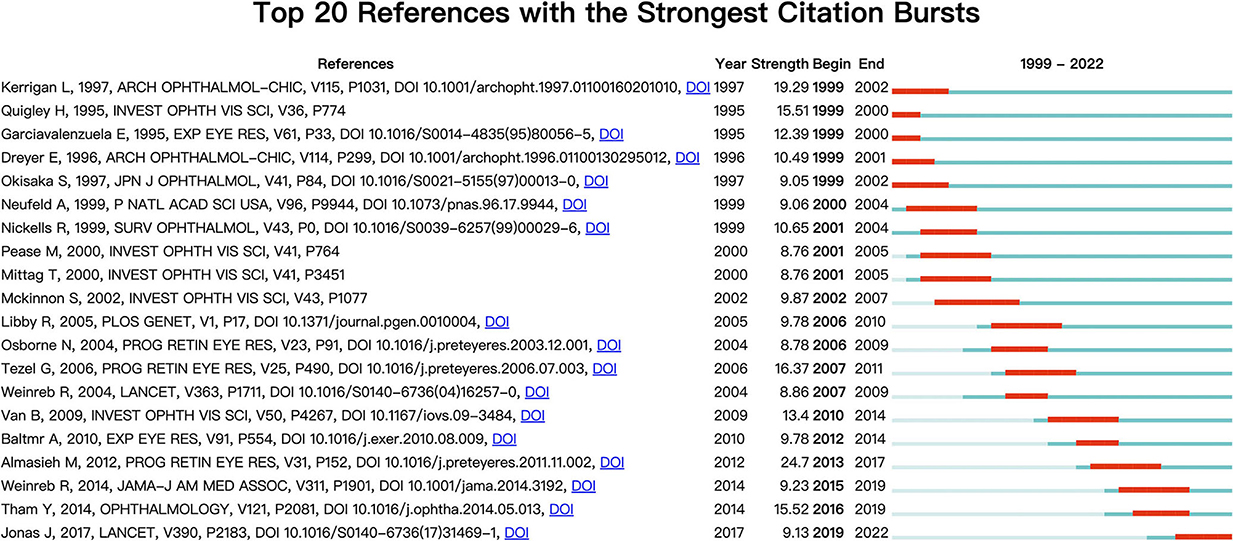
Figure 7. A citation burst is when the citation situation of a paper changes dramatically in a short period of time. The red line indicates the outbreak's duration, and the outbreak's intensity indicates the article's impact. The citation burst is made with CiteSpace.
Keywords can indicate the topic of the publication; therefore, by analyzing keywords, we can understand emerging trends in research. We extracted and clustered the top 50 keywords in the study using VOSviewer (Table 7). The keywords were glaucoma (526 times), apoptosis (384 times), retinal ganglion cells (341 times), neuroprotection (201 times), and oxidative stress (122 times).
We color-coded keywords according to the average year of occurrence (AAY) in the literature in the field, then explored the evolution trend of keywords over time, and visualized them in Figure 8. Recent keywords included mitophagy (AAY:2022.17), endoplasmic reticulum stress (AAY:2019.44), autophagy (AAY:2018.03), melatonin (AAY:2017.83), proteomics (AAY:2016.67), and epigenetics (AAY:2016.15).
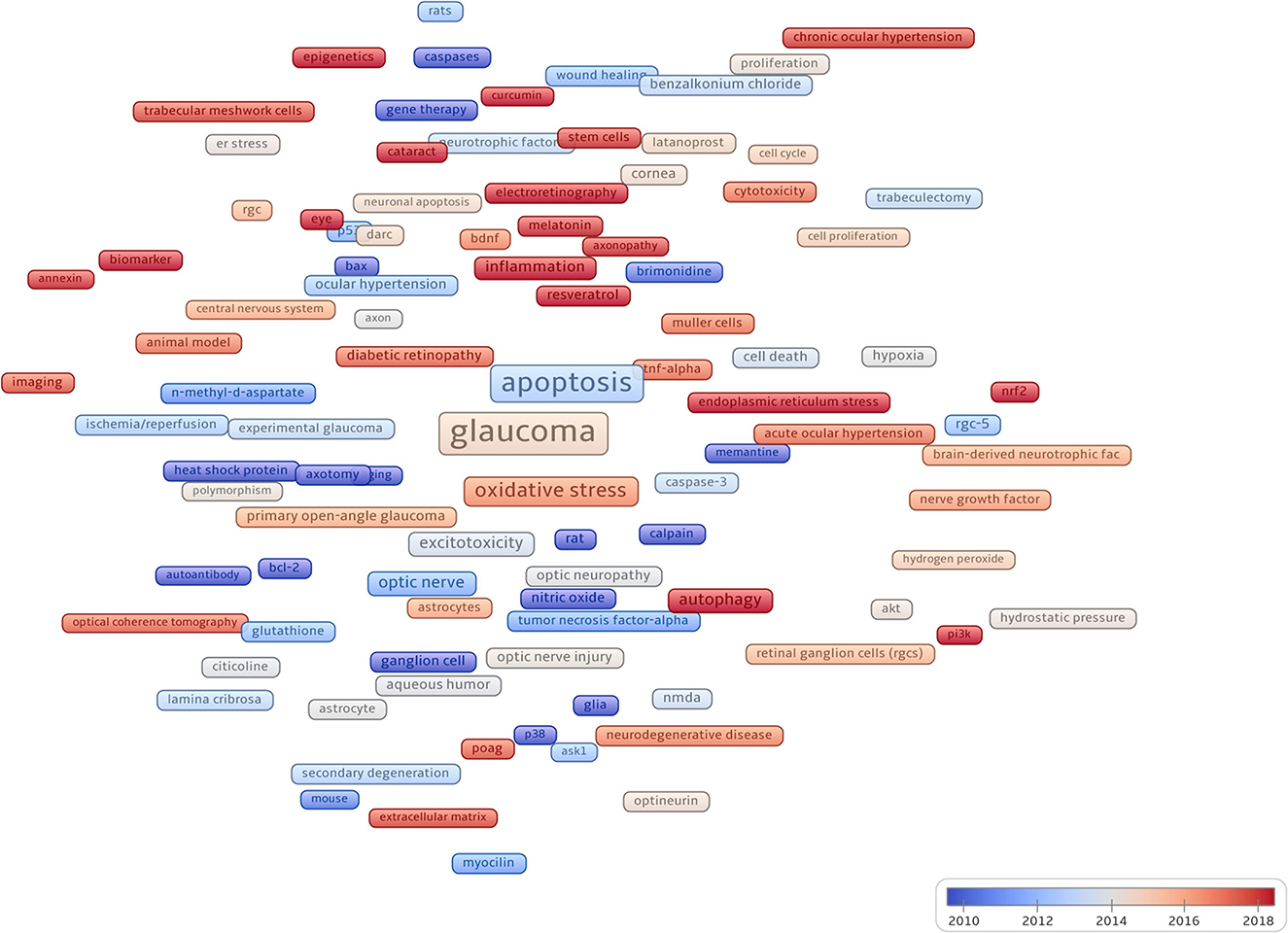
Figure 8. Node square sizes indicate how often keywords appear, cooler colors indicate earlier occurrences of keywords, and warmer colors indicate later occurrences.
Concerning glaucoma treatment progress, we listed the top 60 keywords occurring most frequently in Table 8, covering glaucoma drug treatment, surgical treatment, and eye examination. Figure 9 is a visualization of Table 8. The most frequent keyword was N-Methyl-D-aspartate (NMDA) receptor antagonists (59 times). NMDA-induced excitatory toxicity plays an important role in glaucoma-induced RGC death and the lack of NMDA receptor subunits in experiments can reduce the excitotoxic effect of NMDA, thereby protecting RGCs in mice (Hayashi et al., 2021). A classic treatment for glaucoma is trabeculectomy, which appeared 39 times. In addition, trabeculectomy in combination with antimetabolites, such as mitomycin-c (31 times) or 5-fluorouracil (19 times), has long been known to improve prognosis. We could see a close connection between the three keywords (Figure 9). In summary, we obtained an overview of glaucoma treatment using keyword analysis.
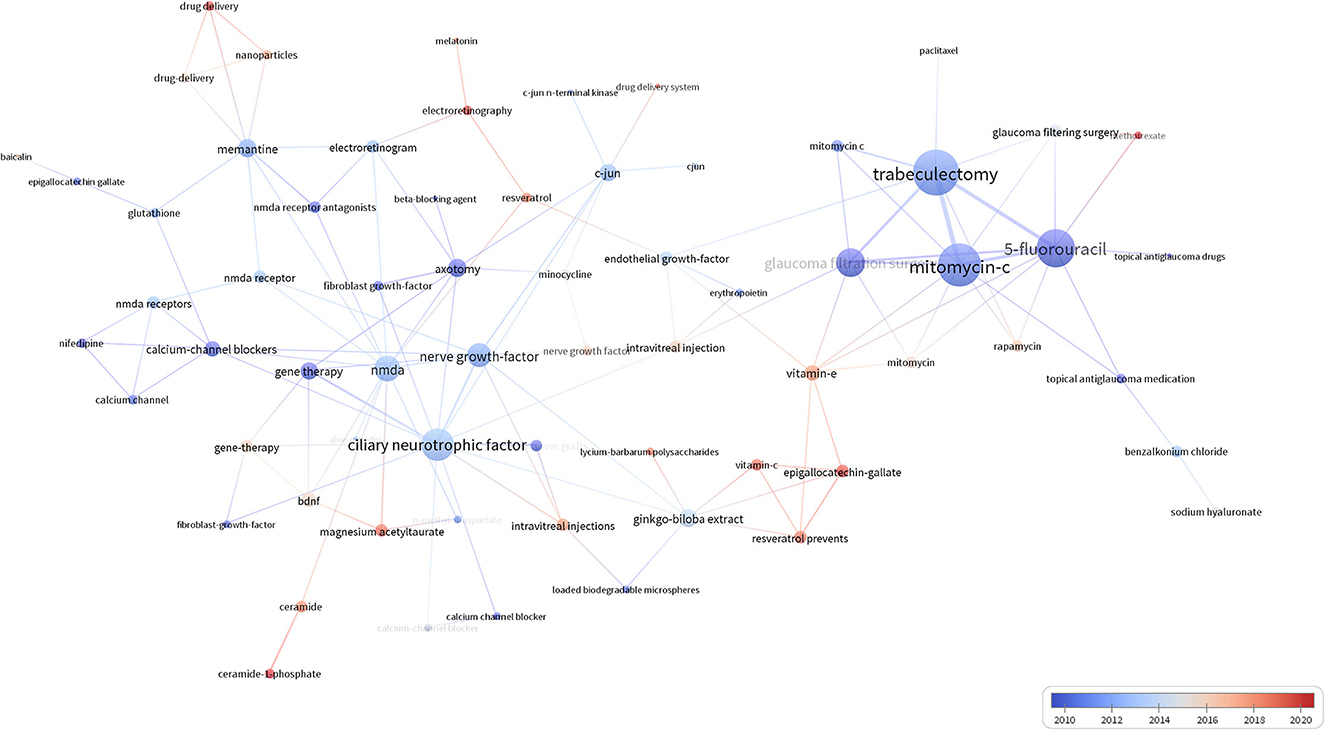
Figure 9. The width of the line between the nodes indicates the strength of the association between the keywords.
In this current study, we used bibliometric tools to visualize and analyze current publications in the area of apoptosis in glaucoma and found that the publications on apoptosis in glaucoma increased over time. In addition, authors and universities in the US and China may be leading research in this field. It should also be noted that a series of advanced research results, technologies, and treatments for glaucoma, such as the discovery of key regulatory mechanisms of RGC apoptosis, are emerging and will provide strategies for glaucoma treatment.
In the current study, we conclude the increasing trend of publications over the years indicates the importance and progress of research in the field of apoptosis in glaucoma. Presently, China, the US, and Japan are the top three countries with the highest number of articles, implying that they are the research centers in this field. The most cited research is Dr. Quigley's (John Hopkins Hospital), “Retinal ganglion cell death in experimental glaucoma and after axotomy occurs by apoptosis (Quigley et al., 1995), which was cited 231 times. It indicated that RGCs die due to apoptosis after axotomy injury and glaucoma. This provided preliminary evidence that apoptosis is the mode of RGC death and may be triggered by excitotoxins, which is important for designing strategies to protect RGCs. The journal Ophthalmology & Visual Science published the most articles on apoptosis in glaucoma. Cell Death & Disease was the journal with the highest impact factor (IF), IF 2021 = 9.685. Prof. Bringmann published a review “Muller cells in the healthy and diseased retina” (Bringmann et al., 2006) in Progress In Retinal and Eye Research, which is one of the top five journals (IF > 10) and is cited 1,178 times. It indicated that retinal diseases such as glaucoma are associated with Muller cell reactivation. Under normal conditions, Muller cells maintain retinal neurons by releasing neurotrophic factors and deactivating excitotoxins. After injury or disease, Muller cells may accelerate neuronal death, as they can be dysregulated leading to a disturbance in glutamate metabolism in the retina, ultimately causing neuronal cell death. A deeper understanding of Muller cell reactivation and targeting may be a useful therapeutic strategy to protect retinal neurons against apoptosis.
Furthermore, we used co-occurrence cluster analysis to produce and analyze the network graph of keywords found in studies on apoptosis in glaucoma. Based on the analysis of keyword frequencies, research hotspots could be identified. Among the top 50 most common keywords were: caspase, akt, bcl-2, and nitric oxide. The keyword results showed that research trends in glaucoma are diversifying, which is not only restricted to ophthalmology but also included progress in cell biology, biochemistry, and genetics. Based on keyword co-occurrence analysis, changes in research trends could be visualized. Initially, keywords including glaucoma, apoptosis, retinal ganglion cells, neuroprotection, and oxidative stress appeared earlier. In the analysis of frequencies and centralities of the keywords, drugs such as “benzalkonium chloride,” “resveratrol,” and “citicoline,” and keywords related to gene research, such as “caspase,” “akt,” and “bcl-2,” appeared earlier. These results suggest that more research on pathological mechanisms and treatment methods was carried out. In addition, after 2016, keywords such as mitophagy, endoplasmic reticulum stress, gliosis, inflammation, autophagy, melatonin, annexin, cytotoxicity, proteomics, and epigenetics were mostly retrieved and showed persistence in recent years, suggesting that this field is the next key direction and are hotspot in studies on apoptosis in glaucoma.
High IOP is the primary risk factor for glaucoma (Cheng et al., 2018). However, IOP measurement alone is not the sole diagnostic standard for glaucoma (Gedde et al., 2021; Steiner et al., 2022). Patients with any symptoms of glaucoma will progress to irreversible RGC loss and optic nerve degeneration (Wang et al., 2017b; Donahue et al., 2021). By analyzing emerging research in glaucoma treatment, some keywords related to examination and treatment have been developed in recent years. The most frequent keyword is NMDA receptor antagonists. NMDA is the most frequent and important excitatory acid in the nervous system, which induces excitatory toxicity and plays an important role in glaucoma-induced RGC death (Hayashi et al., 2021). In experimental glaucoma models, lack of NMDA receptors or NMDA inhibition can reduce the excitotoxic effects of NMDA, thereby protecting RGCs in mice (Hayashi et al., 2021; Sato et al., 2021). As a classic treatment for glaucoma (Olawoye and Etya'ale, 2021; Philippin et al., 2021), trabeculectomy appears 39 times, ranking as the second most frequent treatment keyword. In addition, trabeculectomy in combination with antimetabolites such as mitomycin-c (top three treatment keyword) or 5-fluorouracil (top 12 treatment keyword) has long been known to improve the prognosis for glaucoma treatment (Theventhiran et al., 2021; Al-Mugheiry et al., 2022; Yang et al., 2022). Ophthalmoscopy is a common technology used to detect the optic nerve head and neuronal loss (Coote, 1857; Quigley and Anderson, 1977). We also found that optical coherence tomography (OCT) appeared in 2011 and ranked among the top six treatment keywords, indicating that it is key in research on apoptosis in glaucoma due to its relationship with other keywords. OCT can provide more detailed information about the loss of the optic nerve head and neurons quantitatively. However, in the early stages of glaucoma it is difficult to detect neuronal injuries, which would be permanent (Shao et al., 2022; Zhou et al., 2022). Therefore, early diagnosis and intervention to delay the progress of glaucoma and achieve a better prognosis are urgently needed. Scanning laser ophthalmoscopy, Doppler OCT, and other modified OCTs can be combined to examine capillary morphology and sensitively detect blood flow in the retina in early glaucoma (Aumann et al., 2019; Burns et al., 2019). However, at present, the only effective way to delay glaucoma progression is to reduce IOP using eye drops, surgery, or laser procedures (Schehlein and Robin, 2019; Rolim-De-Moura et al., 2022). Prostaglandins are the most common medication used to lower IOP by accelerating aqueous drainage through the uveal sclera (Jansook and Loftsson, 2022). Other drugs, such as α-adrenergic agonists, β-adrenergic blockers, and carbonic anhydrase inhibitors are second-line drugs that are ineffective in reducing IOP and have side effects (Lu et al., 2017; Nocentini and Supuran, 2019; Stoner et al., 2022). Surgical or laser procedures are recommended when medication cannot sufficiently lower IOP (Schehlein and Robin, 2019; Rolim-De-Moura et al., 2022). In recent years, advances in surgery, drug delivery, and gene therapy have led to a new field of glaucoma treatment (Wan et al., 2021; Tawfik et al., 2022). However, the impaired visual function still becomes serious after lowering the IOP in some patients (Jayanetti et al., 2020; Baudouin et al., 2021) as RGCs and the optic nerve irreversibly degenerate (Jayanetti et al., 2020; Baudouin et al., 2021). Therefore, research on the pathological mechanisms and development of neuroprotective treatments are still hotspots in glaucoma research.
Our literature retrieval work was conducted from 1 January 1999 to 1 November 2022. Therefore, articles published after 2 November 2022 with advanced research results that met the search criteria were not included, making the number of articles in our database less than the total number today. In addition, we only included articles and reviews as we aimed to control the quality of publications as much as possible. Other types of publications, such as case reports, meta-analyses, and books were excluded, even though, they may contain valuable information. Apoptosis in glaucoma encompasses several research topics. Although we made our best effort to retrieve more relevant publications, we may have overlooked important research and results using our current retrieval formula considering the limitations of bibliometric tools such as CiteSpace and VOSviewer.
This study aimed to determine the current and future trends and hotspots of apoptosis in glaucoma. We used bibliometric tools to visualize and analyze publications in this field and found that publications on apoptosis in glaucoma increased over time. It is an emerging series of advanced research involving technologies and treatments for glaucoma, such as the discovery of key regulatory mechanisms of RGC apoptosis, which will provide precise strategies for glaucoma treatment. In summary, this study can deepen our understanding of the trends and frontiers of apoptosis in glaucoma and provide guidelines for future research and treatment.
The raw data supporting the conclusions of this article will be made available by the authors, without undue reservation.
S-CW designed the experiments, interpreted the data, and revised the manuscript. J-HZ and M-JW performed the experiments, prepared the figures, and wrote the manuscript. Y-TT and JL helped to perform the experiments and prepared the figures. All authors read, discussed, and approved the final manuscript.
This study was supported by the National Natural Science Foundation of China, No. 82101126, Natural Science Foundation of Hunan Province, No. 2021JJ40873, the Hunan Provincial Natural Science Foundation of China, No. 2019JJ50696, and the Scientific Research Launch Project for new employees of the Second Xiangya Hospital of Central South University.
The authors declare that the research was conducted in the absence of any commercial or financial relationships that could be construed as a potential conflict of interest.
All claims expressed in this article are solely those of the authors and do not necessarily represent those of their affiliated organizations, or those of the publisher, the editors and the reviewers. Any product that may be evaluated in this article, or claim that may be made by its manufacturer, is not guaranteed or endorsed by the publisher.
Al-Mugheiry, T.S., Clark, A., and Broadway, D.C. (2022). The Norwich trabeculectomy study: risk factor analysis for the development of adverse, thin cystic blebs. Acta Ophthalmol. 100, e1463–e1469. doi: 10.1111/aos.15193
Aumann, S., Donner, S., Fischer, J., and Muller, F. (2019). “Optical Coherence Tomography (OCT): Principle and Technical Realization,” in High Resolution Imaging in Microscopy and Ophthalmology: New Frontiers in Biomedical Optics, ed. J.F. Bille. (Cham: CH) 59–85. doi: 10.1007/978-3-030-16638-0_3
Baudouin, C., Kolko, M., Melik-Parsadaniantz, S., and Messmer, E.M. (2021). Inflammation in Glaucoma: from the back to the front of the eye, and beyond. Prog. Retin. Eye Res. 83, 100916. doi: 10.1016/j.preteyeres.2020.100916
Bringmann, A., Pannicke, T., Grosche, J., Francke, M., Wiedemann, P., Skatchkov, S.N., et al. (2006). Muller cells in the healthy and diseased retina. Prog. Retin. Eye Res. 25, 397–424. doi: 10.1016/j.preteyeres.2006.05.003
Burns, S.A., Elsner, A.E., Sapoznik, K.A., Warner, R.L., and Gast, T.J. (2019). Adaptive optics imaging of the human retina. Prog. Retin. Eye Res. 68, 1–30. doi: 10.1016/j.preteyeres.2018.08.002
Chen, R., Duan, Z.Y., Duan, X.H., Chen, Q.H., and Zheng, J. (2022a). Progress in research on gut microbiota in ethnic minorities in China and consideration of intervention strategies based on ethnic medicine: a review. Front. Cell. Infect. Microbiol. 12, 1027541. doi: 10.3389/fcimb.2022.1027541
Chen, W., Liu, P., Liu, D., Huang, H., Feng, X., Fang, F., et al. (2022b). Maprotiline restores ER homeostasis and rescues neurodegeneration via Histamine Receptor H1 inhibition in retinal ganglion cells. Nat. Commun. 13, 6796. doi: 10.1038/s41467-022-34682-y
Cheng, S.Y., Wang, S.C., Lei, M., Wang, Z., and Xiong, K. (2018). Regulatory role of calpain in neuronal death. Neural Regen Res 13, 556–562. doi: 10.4103/1673-5374.228762
Chitranshi, N., Dheer, Y., Abbasi, M., You, Y., Graham, S.L., and Gupta, V. (2018). Glaucoma pathogenesis and neurotrophins: focus on the molecular and genetic basis for therapeutic prospects. Curr. Neuropharmacol. 16, 1018–1035. doi: 10.2174/1570159X16666180419121247
Coote, H. (1857). Clinical lecture on the employment of the ophthalmoscope in the investigation of deep-seated diseases of the eye. Br. Med. J. 1, 256–257. doi: 10.1136/bmj.s4-1.13.256-a
Cordeiro, M.F., Hill, D., Patel, R., Corazza, P., Maddison, J., and Younis, S. (2022). Detecting retinal cell stress and apoptosis with DARC: progression from lab to clinic. Prog. Retin. Eye Res. 86, 100976. doi: 10.1016/j.preteyeres.2021.100976
Dai, Z., Xu, S., Wu, X., Hu, R., Li, H., He, H., et al. (2022). Knowledge mapping of multicriteria decision analysis in healthcare: a bibliometric analysis. Front Public Health 10, 895552. doi: 10.3389/fpubh.2022.895552
Donahue, R.J., Fehrman, R.L., Gustafson, J.R., and Nickells, R.W. (2021). BCLXL gene therapy moderates neuropathology in the DBA/2J mouse model of inherited glaucoma. Cell Death Dis. 12, 781. doi: 10.1038/s41419-021-04068-x
Gedde, S. J., Vinod, K., Wright, M. M., Muir, K. W., Lind, J. T., Chen, P. P., et al. (2021). Primary open-angle glaucoma preferred practice pattern(R). Ophthalmology 128, P71–P150. doi: 10.1016/j.ophtha.2020.10.022
Hayashi, H., Mori, M., Harashima, M., Hashizume, T., Furiya, M., Mukaigaito, C., et al. (2021). Apolipoprotein E-containing lipoproteins and LRP1 protect From NMDA-induced excitotoxicity associated with reducing alpha2-macroglobulin in muller glia. Invest. Ophthalmol. Vis. Sci. 62, 23. doi: 10.1167/iovs.62.13.23
Hu, T., Wang, S., Zeng, L., Xiong, K., Chen, D., and Huang, J. (2020). Regional Expression of Act-MMP3 contributes to the selective loss of neurons in ganglion cell layers following acute retinal ischemia/reperfusion injury. Curr. Eye Res. 45, 591–603. doi: 10.1080/02713683.2019.1684523
Hu, X., Zhao, G. L., Xu, M. X., Zhou, H., Li, F., Miao, Y., et al. (2021). Interplay between Muller cells and microglia aggravates retinal inflammatory response in experimental glaucoma. J. Neuroinflammation 18, 303. doi: 10.1186/s12974-021-02366-x
Hu, X. M., Li, Z. X., Zhang, D. Y., Yang, Y. C., Zheng, S. Y., Zhang, Q., et al. (2022). Current research and clinical trends in rosacea pathogenesis. Heliyon 8, e10874. doi: 10.1016/j.heliyon.2022.e10874
Jansook, P., and Loftsson, T. (2022). Aqueous prostaglandin eye drop formulations. Pharmaceutics 14. doi: 10.3390/pharmaceutics14102142
Jayanetti, V., Sandhu, S., and Lusthaus, J. A. (2020). The latest drugs in development that reduce intraocular pressure in ocular hypertension and glaucoma. J. Exp. Pharmacol. 12, 539–548. doi: 10.2147/JEP.S281187
Ju, W. K., Perkins, G. A., Kim, K. Y., Bastola, T., Choi, W. Y., and Choi, S. H. (2022). Glaucomatous optic neuropathy: Mitochondrial dynamics, dysfunction and protection in retinal ganglion cells. Prog. Retin. Eye Res. 101136. doi: 10.1016/j.preteyeres.2022.101136
Kerrigan, L. A., Zack, D. J., Quigley, H. A., Smith, S. D., and Pease, M. E. (1997). TUNEL-positive ganglion cells in human primary open-angle glaucoma. Arch. Ophthalmol. 115, 1031–1035. doi: 10.1001/archopht.1997.01100160201010
Liu, S. M., Liao, L. S., Huang, J. F., and Wang, S. C. (2022). Role of CAST-Drp1 pathway in retinal neuron-regulated necrosis in experimental glaucoma. Curr. Med. Sci. 3, 8. doi: 10.1007/s11596-022-2639-8
Lu, L. J., Tsai, J. C., and Liu, J. (2017). Novel pharmacologic candidates for treatment of primary open-angle glaucoma. Yale J. Biol. Med. 90, 111–118.
Nocentini, A., and Supuran, C.T. (2019). Adrenergic agonists and antagonists as antiglaucoma agents: a literature and patent review (2013–2019). Expert Opin. Ther. Pat. 29, 805–815. doi: 10.1080/13543776.2019.1665023
Olawoye, O., and Etya'ale, D. (2021). Selective laser trabeculoplasty versus 0.5% timolol eye drops in the management of glaucoma in Tanzania. Lancet Glob Health 9, e1489–e1490. doi: 10.1016/S2214-109X(21)00402-2
Philippin, H., Matayan, E., Knoll, K.M., Macha, E., Mbishi, S., Makupa, A., et al. (2021). Selective laser trabeculoplasty vs. 0.5% timolol eye drops for the treatment of glaucoma in Tanzania: a randomised controlled trial. Lancet Glob Health 9, e1589–e1599. doi: 10.1016/S2214-109X(21)00348-X
Quigley, H. A., and Anderson, D. R. (1977). The histologic basis of optic disk pallor in experimental optic atrophy. Am. J. Ophthalmol. 83, 709–717. doi: 10.1016/0002-9394(77)90138-6
Quigley, H. A., Nickells, R. W., Kerrigan, L. A., Pease, M. E., Thibault, D. J., and Zack, D. J. (1995). Retinal ganglion cell death in experimental glaucoma and after axotomy occurs by apoptosis. Invest. Ophthalmol. Vis. Sci. 36, 774–786.
Rolim-De-Moura, C. R., Paranhos, A. Jr., Loutfi, M., Burton, D., Wormald, R., and Evans, J. R. (2022). Laser trabeculoplasty for open-angle glaucoma and ocular hypertension. Cochrane Database Syst. Rev. 8, CD003919. doi: 10.1002/14651858.CD003919.pub3
Romero, L., and Portillo-Salido, E. (2019). Trends in sigma-1 receptor research: a 25-year bibliometric analysis. Front. Pharmacol. 10, 564. doi: 10.3389/fphar.2019.00564
Sato, K., Sato, T., Ohno-Oishi, M., Ozawa, M., Maekawa, S., Shiga, Y., et al. (2021). CHOP deletion and anti-neuroinflammation treatment with hesperidin synergistically attenuate NMDA retinal injury in mice. Exp. Eye Res. 213, 108826. doi: 10.1016/j.exer.2021.108826
Schehlein, E. M., and Robin, A. L. (2019). Rho-associated kinase inhibitors: evolving strategies in glaucoma treatment. Drugs 79, 1031–1036. doi: 10.1007/s40265-019-01130-z
Shao, C., Li, Z., Zhang, C., Zhang, W., He, R., Xu, J., et al. (2022). Optical diagnostic imaging and therapy for thyroid cancer. Mater Today Bio 17, 100441. doi: 10.1016/j.mtbio.2022.100441
Steiner, S., Schwarzhans, F., Desissaire, S., Resch, H., Fischer, G., Pircher, M., et al. (2022). Birefringent properties of the peripapillary retinal nerve fiber layer in healthy and glaucoma subjects analyzed by polarization-sensitive OCT. Invest. Ophthalmol. Vis. Sci. 63, 8. doi: 10.1167/iovs.63.12.8
Stoner, A., Harris, A., Oddone, F., Belamkar, A., Verticchio Vercellin, A. C., Shin, J., et al. (2022). Topical carbonic anhydrase inhibitors and glaucoma in 2021: where do we stand? Br. J. Ophthalmol. 106, 1332–1337. doi: 10.1136/bjophthalmol-2021-319530
Tawfik, M., Chen, F., Goldberg, J. L., and Sabel, B. A. (2022). Nanomedicine and drug delivery to the retina: current status and implications for gene therapy. Naunyn Schmiedebergs. Arch. Pharmacol. 395, 1477–1507. doi: 10.1007/s00210-022-02287-3
Tham, Y. C., Li, X., Wong, T. Y., Quigley, H. A., Aung, T., and Cheng, C. Y. (2014). Global prevalence of glaucoma and projections of glaucoma burden through 2040: a systematic review and meta-analysis. Ophthalmology 121, 2081–2090. doi: 10.1016/j.ophtha.2014.05.013
Theventhiran, A. B., Kim, G., and Yao, W. (2021). Fornix-based versus limbal-based conjunctival trabeculectomy flaps for glaucoma. Cochrane Database Syst Rev 8, CD009380. doi: 10.1002/14651858.CD009380.pub3
Wan, C. R., Muya, L., Kansara, V., and Ciulla, T. A. (2021). suprachoroidal delivery of small molecules, nanoparticles, gene and cell therapies for ocular diseases. Pharmaceutics 13. doi: 10.3390/pharmaceutics13020288
Wang, S., Hu, T., Wang, Z., Li, N., Zhou, L., Liao, L., et al. (2017a). Macroglia-derived thrombospondin 2 regulates alterations of presynaptic proteins of retinal neurons following elevated hydrostatic pressure. PLoS ONE 12, e0185388. doi: 10.1371/journal.pone.0185388
Wang, S., Liao, L., Huang, Y., Wang, M., Zhou, H., Chen, D., et al. (2019). Pin1 is regulated by CaMKII activation in glutamate-induced retinal neuronal regulated necrosis. Front. Cell. Neurosci. 13, 276. doi: 10.3389/fncel.2019.00276
Wang, S., Liao, L., Wang, M., Zhou, H., Huang, Y., Wang, Z., et al. (2017b). Pin1 promotes regulated necrosis induced by glutamate in rat retinal neurons via CAST/Calpain2 pathway. Front. Cell. Neurosci. 11, 425. doi: 10.3389/fncel.2017.00425
Wang, S. C., Hu, X. M., and Xiong, K. (2023). The regulatory role of Pin1 in neuronal death. Neural Regen Res 18, 74–80. doi: 10.4103/1673-5374.341043
Yan, W. T., Yang, Y. D., Hu, X. M., Ning, W. Y., Liao, L. S., Lu, S., et al. (2022). Do pyroptosis, apoptosis, and necroptosis (PANoptosis) exist in cerebral ischemia? Evidence from cell and rodent studies. Neural Regen Res 17, 1761–1768. doi: 10.4103/1673-5374.331539
Yan, W. T., Zhao, W. J., Hu, X. M., Ban, X. X., Ning, W. Y., Wan, H., et al. (2023). PANoptosis-like cell death in ischemia/reperfusion injury of retinal neurons. Neural. Regen. Res. 18, 357–363. doi: 10.4103/1673-5374.346545
Yang, H. Y., Chi, S. C., Ko, Y. C., Chen, M. J., Kuang, T. M., Chang, Y. F., et al. (2022). Bleb-related infection after primary trabeculectomy: medical chart reviews from 1993 to 2021. Br. J. Ophthalmol. 3, 1429. doi: 10.1136/bjo-2022-321429
Zhang, J. H., Ni, S. Y., Tan, Y. T., Luo, J., and Wang, S. C. (2022). A bibliometric analysis of PIN1 and cell death. Front. Cell Dev. Biol. 10, 1043725. doi: 10.3389/fcell.2022.1043725
Zhang, Q., Wan, X. X., Hu, X. M., Zhao, W. J., Ban, X. X., Huang, Y. X., et al. (2021). Targeting programmed cell death to improve stem cell therapy: implications for treating diabetes and diabetes-related diseases. Front Cell Dev Biol. 9, 809656. doi: 10.3389/fcell.2021.809656
Zhao, L., Li, J., Feng, L., Zhang, C., Zhang, W., Wang, C., et al. (2022). Depicting developing trend and core knowledge of primary open-angle glaucoma: a bibliometric and visualized analysis. Front. Med. 9, 922527. doi: 10.3389/fmed.2022.922527
Keywords: bibliometric, CiteSpace, VOSviewer, apoptosis, glaucoma, retinal ganglion cell
Citation: Zhang J-H, Wang M-J, Tan Y-T, Luo J and Wang S-C (2023) A bibliometric analysis of apoptosis in glaucoma. Front. Neurosci. 17:1105158. doi: 10.3389/fnins.2023.1105158
Received: 22 November 2022; Accepted: 09 January 2023;
Published: 06 February 2023.
Edited by:
Wensi Tao, University of Miami Health System, United StatesReviewed by:
Fangfang Song, Wuhan University, ChinaCopyright © 2023 Zhang, Wang, Tan, Luo and Wang. This is an open-access article distributed under the terms of the Creative Commons Attribution License (CC BY). The use, distribution or reproduction in other forums is permitted, provided the original author(s) and the copyright owner(s) are credited and that the original publication in this journal is cited, in accordance with accepted academic practice. No use, distribution or reproduction is permitted which does not comply with these terms.
*Correspondence: Shu-Chao Wang,  d2FuZ3NodWNoYW9AY3N1LmVkdS5jbg==
d2FuZ3NodWNoYW9AY3N1LmVkdS5jbg==
†These authors have contributed equally to this work
Disclaimer: All claims expressed in this article are solely those of the authors and do not necessarily represent those of their affiliated organizations, or those of the publisher, the editors and the reviewers. Any product that may be evaluated in this article or claim that may be made by its manufacturer is not guaranteed or endorsed by the publisher.
Research integrity at Frontiers

Learn more about the work of our research integrity team to safeguard the quality of each article we publish.